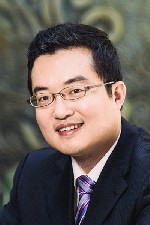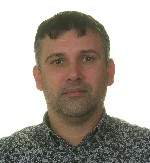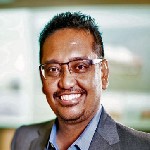Monday, 29 April 2019 |
9:45–10:30 (Mayang Sari Grand Ballroom)

Accessing From the Sky: UAV Communications for 5G and Beyond
Rui Zhang, Dean's Chair Professor, National University of Singapore
The integration of the dramatically increasing volume of unmanned aerial vehicles (UAVs) or drones into the future 5G and beyond wireless networks calls for a paradigm shift on the design of traditional cellular systems for terrestrial-only communications. In particular, how to realize cellular-connected UAV communications and UAV-assisted terrestrial communications are both practically appealing as well as challenging, due to the high altitude and high mobility of UAVs, the unique channel characteristics of UAV-ground links, the stringent constraints imposed by the size, weight and power (SWAP) limitations of UAVs, as well as the new degree of freedom by exploiting UAV placement/trajectory and communication co-design. Substantial research efforts from both academia and industry have been devoted to advancing this exciting new field, with remarkable progress made especially in the past couple of years. In this talk, we will provide a comprehensive overview of the state-of-the-art results on UAV-cellular integration, with a particular emphasis placed on the latest research findings on aerial-ground interference management and trajectory optimization in UAV communications. Open challenges and promising directions for future research will also be highlighted.
Biography—Dr. Rui Zhang (IEEE Fellow) received the Ph.D. degree from Stanford University in electrical engineering in 2007. He is now a Dean’s Chair Professor in the Department of Electrical and Computer Engineering, National University of Singapore. His research interests include wireless information and power transfer, UAV communications, MIMO, cognitive radio, and optimization methods. He has published over 350 papers, which have been cited more than 27,000 times. He has been listed as a Highly Cited Researcher by Thomson Reuters / Clarivate Analytics since 2015, and was recognized in both Scientific Fields of Computer Science and Engineering in 2018. His work have received several IEEE awards, including the IEEE Marconi Prize Paper Award in Wireless Communications, the IEEE Communications Society Heinrich Hertz Prize Paper Award, the IEEE Signal Processing Society Best Paper Award and Donald G. Fink Overview Paper Award. He has served as an Editor for several IEEE journals, including TWC, TCOM, JSAC, TSP, etc., and as TPC co-chair or organizing committee member for over 30 international conferences. He is an IEEE Distinguished Lecturer.
Tuesday, 30 April 2019 |
9:00–9:45 (Mayang Sari Grand Ballroom)

Connected Mobility Initiatives in New National Automotive Policy (NAP) 2019
Madani Sahari, CEO, Malaysia Automotive, Robotics & IoT Institute (MARii)
The National Automotive Policy (NAP) was first introduced on 22 March 2006 by Economic Planning Unit (EPU) to transform the domestic automotive industry and optimize integration of the industry towards competitive regional and global industry network. The NAP was first reviewed in 2009 by the Ministry of International Trade and Industry (MITI) to further enhance the capability and competitiveness of the domestic automotive industry by creating a more conducive investment environment.
The NAP was again reviewed in year 2014 as the Government liberated the automotive industry and vigorously promoted enhancing the competitiveness and sustainability of the domestic automotive industry. The NAP 2014 focused on promoting Malaysia as a hub for Energy Efficient Vehicles (EEV) in ASEAN. Together with policy review, 6 comprehensive roadmaps were also established which act as guidelines for the transformation of domestic automotive industry towards global competitiveness.
The global evolution of technology has given significant impact to the automotive industry towards connected mobility. This has provided the need for the third review of NAP in aligning the domestic automotive industry with a global mobility ecosystem. This review of the NAP will further enhance the current framework of NAP 2014 with crucial technology elements such as Next Generation Vehicle (NxGV), Mobility as a Services (MaaS) and Industrial Revolution (IR) 4.0 including Artificial Intelligence (AI).
Biography—Dato’ Madani Sahari is a highly qualified executive manager with more than 18 years’ experience in manufacturing and service industries of the automotive sector. Dato’ Madani carries with him vast experience with national and international automotive manufacturers such as Proton, Perodua, Honda, Toyota, Renault, Hyundai, Nissan and General Motors in the areas of strategic collaboration, project development and manufacturing. He graduated from the University of Lorraine (formerly Nancy-Université), France, with a degree in Industrial Technology and is also a Certified Quality Engineer.
At present, Dato’ Madani is the CEO of the Malaysia Automotive Institute (MAI), a focal point and coordination centre, under the custodian of the Ministry of International Trade and Industry (MITI). MAI oversees the development of the Malaysian automotive industry in all matters, including formulating of the national automotive policy, development of the local automotive roadmap and its expansion programmes, managing manpower development programme, formulating and coordinating automotive related research. Dato’ Madani’s knowledge and expertise also encompasses Strategic Planning & Partnership, Corporate Service Development, Business Process Reengineering, Project Management, Marketing, Quality Management, Safety, Health and Environment, Manufacturing and Six Sigma, and has a strong track record of proven ability to turnaround financially or operationally underperforming organizations.
9:45–10:30 (Mayang Sari Grand Ballroom)

Demystifying Artificial Intelligence in Wireless Communications: Perspectives and Challenges
Haris Gacanin, Department Head, Nokia Bell Labs
With artificial intelligence (AI) machines can be designed to perform “autonomous” tasks (e.g. planning, problem solving) without being programmed to accomplish a single (repetitive) task, while being adaptive to different environments. We presume that AI provides techniques to enable autonomous wireless systems with stringent service requirements in real time. Such system requires full awareness of its environment in real time while being designed not only through data-driven methodology by ML, but through knowledge management by AI. This talk discusses challenges and opportunities to embrace AI in the design of autonomous wireless systems. By looking beyond recent data-driven methodology for prediction problems such as deep learning, we introduce the concept of machine intelligence by employing broader disciplines of AI such as sensing, reasoning, active learning, and knowledge management. We start discussion by summarizing the properties of training-free and training-based methods of AI in wireless environment. To understand limitations of these methods we compare the traditional optimization theory, deep learning and reinforcement learning in wireless environment. Finally, we discuss the conceptual functions of autonomous agent with knowledge management. The talk provokes new coming challenges and unveil interesting future directions across multi-disciplinary research areas.
Biography—Haris Gačanin received his Dipl.-Ing. degree in Electrical engineering from University of Sarajevo in 2000. In 2005 and 2008, respectively, he received MSc and PhD from Tohoku University in Japan. He worked at Tohoku University until 2010 as Assistant Professor and joined Alcatel-Lucent (now Nokia) in 2010, where he established research on data-driven analysis of communication systems at physical and media access layers. Currently, he is department head at Bell Labs and adjunct teaching professor at KU Leuven. His professional interests relate to research confluence between artificial intelligence and physical-layer communications to establish autonomous wireless systems. He has 200+ scientific publications (journals, conferences and patens) and invited/tutorial talks. He is senior member of IEEE and IEICE. He is recipient of 2018 Nokia Innovation Awards, IEICE Communication Systems Best Paper Award (joint 2014, 2015, 2017), The 2013 Alcatel-Lucent Award of Excellence, the 2012 KDDI Foundation Research Award, the 2009 KDDI Foundation Research Grant Award, the 2008 JSPS Postdoctoral Fellowships for Foreign Researchers, the 2005 Active Research Award in Radio Communications, 2005 Vehicular Technology Conference (VTC 2005-Fall) Student Paper Award from IEEE VTS Japan Chapter and the 2004 Institute of IEICE Society Young Researcher Award.
Wednesday, 1 May 2019 |
9:00–9:45 (Mayang Sari Ballroom)

How Will AI Drive Innovation in Drone/UAV Industries?
Kamarul A. Muhamed, Founder & CEO, Aerodyne Group, Malaysia
Industrial systems are transforming from automated to autonomous. The systems that, without manual intervention, can change their behavior in response to unanticipated events during operation are called “autonomous”. In the recent years, we have seen many explorations in both academia and industries on such systems, ranging from driverless cars, unmanned aviation vehicles (UAV), automated guided vehicles (AGV), autonomous robots, autonomous ships, unmanned mining equipment, unmanned warehouses and distribution centers, unmanned groceries and shops, unmanned hotels and restaurants, and even autonomous power grids. Compared with traditional automatic control, the artificial intelligence or machine learning techniques will play essential roles in such systems to enable the autonomous execution of complex tasks in more dynamic and unstructured environments with unpredictable changes. Malaysia based Aerodyne has carved a global name for itself by combining drones with AI’s powerful analytics. Apart from asset inspection, management and project monitoring in various sectors, Aerodyne also actively provides services in geospatial intelligence, emergency response, 2D and 3D mapping and precision agriculture. As a global UAV service provider, Aerodyne is benefitted from the advancement of artificial intelligence. The development of fully-autonomous UAV and BVLOS (Beyond Visual Line of Sight) technology is already front and centre of Aerodyne Group’s development roadmap, with live projects around the world incorporating artificial intelligence, nested drones, 5G connectivity and automated surveillance. In this talk, Kamarul will discuss on the various innovation on smart intelligence that advancing the UAV/Drone application.
Biography—Kamarul is the Founder and CEO of Aerodyne Group. He is an industry veteran with 25 years of experience in enterprise software and security, interactive multimedia application and software development and one of drone application pioneers with solutions delivery since 2007. He began his career in London as an Auditor after graduating from Nottingham Trent University and later became the Director and Country Manager for Computer Associates 13 years after his return to Malaysia. In 2014, he founded Aerodyne Group, an AI-driven drone-based total enterprise managed solutions provider ranked 7th globally, 260-strong in 21 countries and a recipient of Frost and Sullivan’s UAV company of the year 2018. To focus on innovation and drone applications for enterprise’s digital transformation. In less than 4 years, Aerodyne has grown from a startup of 3 co-founders to a 240-strong global AI-driven drone managed solution provider operating in over 20 countries and growing. Under his stewardship, in March 2018, Aerodyne was ranked 7th in a list of top 20 global drone service providers by Drone Industry Insights. Aerodyne is also the recipient of Frost and Sullivan’s UAV Company of the year 2018 and before that in 2016, Entrepreneurial Company of the year in drone category.
9:45–10:30 (Mayang Sari Grand Ballroom)

Cognitive Radios & AI: Enablers for Extreme Densities in Communications, or a Flop?
Petri Mähönen, RWTH Aachen University
In this talk, I will explore the question where we are heading up with the future extremely dense communications networks. We are facing the challenge how to engineer dynamic ultra-dense networks that can support extreme scalability. My argument will be that the scalability and realistic user plane design parameters with deployment models will be crucial design conditions for the success of the future systems and interesting research. I plan to examine the role of cognitive radio technologies and different emerging artificial intelligence algorithms in this domain. I take a liberty and dare to ask if we should consider 5G as a revolution or evolutionary step in the context, and perhaps even more controversially how much we should care about AI/ML – and if we do care, where the challenges and real opportunities might reside for the research community in the coming decade? In general, I will argue in the talk that we need to think bolder research avenues, but grounded to solid realism, if we want to sustain both the economic health and scalability of wireless networks.
Biography—Dr Petri Mähönen is a full professor and a founding director of the institute for networked systems at RWTH Aachen University, Germany. He joined RWTH Aachen as the holder of Ericsson endowed chair of wireless networks in 2002. Before joing to RWTH Aachen he was a professor and research director at the Centre for Wireless Communications in Finland. He is recipient of Telenor Research prize and co-recipient of IEEE VTC Jack Neubauer Memorial Award. He has given invited talks in a number of different conferences, universities, and industry. Apart of academic publishing, he has been a part of teams who have invented and successfully technology transferred several patent families for industrial use. He served as co-TPC chair and as a general chair for IEEE DySPAN conferences, which is the major IEEE conference in the area of cognitive radios and dynamic spectrum access. His group has been in forefront on developing machine learning based cognitive radio technologies, dynamic spectrum access techniques, novel access methods, and earlier in his career he was a project lead for development and implementation for one of the first 40 GHz cellular broadband systems. In general, and foremost, he likes to tinker with cool technology and interesting problems.

